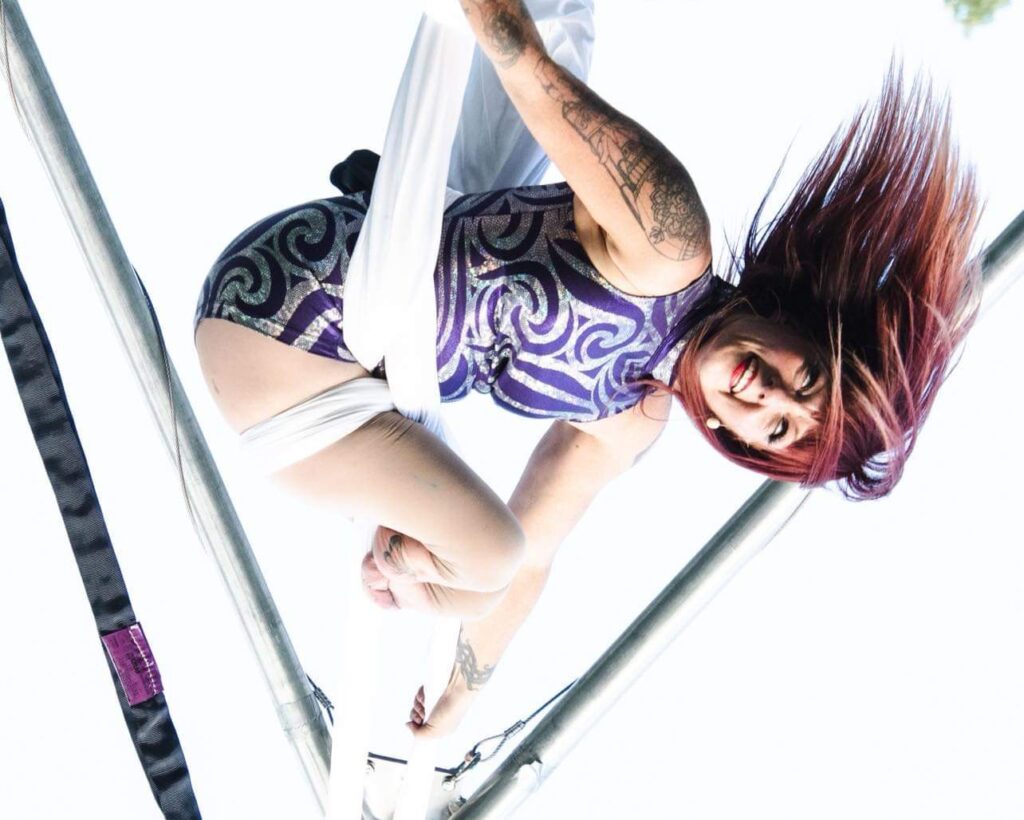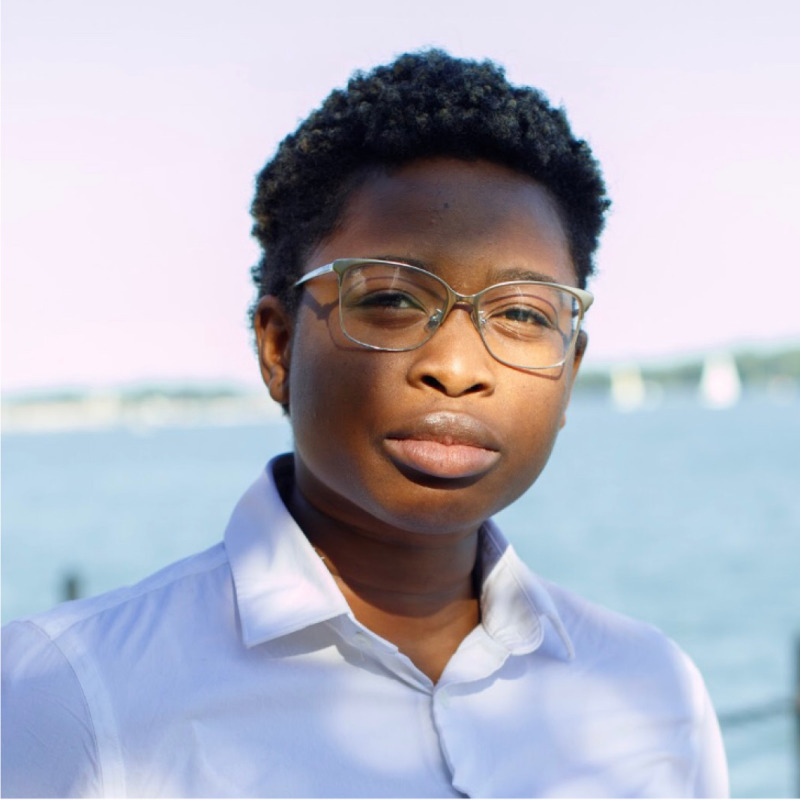5 Q’s with Erin Ball

5 Q’s, 5 Femmes is a short series facilitated by writer Kemi King, interviewing five femme identifying artists; getting to know a little bit about them and their craft.
Erin Ball identifies as a white, Mad (from the Mad Pride Movement), Disabled treaty inhabitant. She is a double below knee amputee and circus artist based in Katarokwi/Kingston. She is the director of Kingston Circus Arts and is the co-founder of LEGacy Circus (a performance company co-created with Mad artist, Vanessa Furlong). Erin achieved Disability in 2014 and she took a year off. She has since returned to her passion of training, coaching and performing with a focus of including as many people in her audiences, as collaborators and performers in shows, as well as students in her classes. She has travelled internationally to perform and teach. She strives for representation, access and inclusion in the arts.
This interview has been edited for clarity and length.
I’m here today with Erin Ball. Erin, how are you doing?
Hi Kemi, I’m doing really well. Thank you so much for asking me to do this.
Thank you so much for being here! For my first question: what is something doing circus has taught you?
Doing circus has taught me so many things. It has taught me that not everything is easy. And sometimes it’s really worth it to stick with things even though it may seem impossible for a very long time; that things can happen with time.
It has taught me about combining movement and storytelling, community, and that there is a lot of space and possibility in exploring outside of traditional standards.
I find that extremely fulfilling.
That all sounds great, thank you. I find that your work is often very playful. What are the impulses behind that?
I think that my work had two very distinct time periods. One is still evolving and changing. Then there’s the one before—before becoming a double below knee amputee. There were definitely some playful aspects, and circus kind of fulfilled that playful need that exists with me. But the art I was creating at that time was more traditional because that was my lived experience at the time.
After becoming a double below the knee amputee, and along my process of uncovering all of the internalized ableism and noticing the differences in the world as a Disabled circus artist, I felt that the journey really brought that playfulness to the forefront. It was very much part of me figuring out how I had a space in circus and using it as part of my healing as well. At some point after the grieving process, humour and playfulness was the thing. I think once I realized that my feet could be anything, and that they weren’t a limitation as is often portrayed, there were just so many possibilities. I mean there are good things and bad things, but being playful and dreaming up stories around the feet was very interesting to me.
Yes! I really like that—that your feet can be anything. I really like that idea of an expansive possibility. You are not only limited to “what you know.” Then there is space for exploring alternatives. I think that’s really gorgeous.
Thank you. Working like this, especially in an art form that so often emphasizes pointing feet and all these straight lines, then finding myself in a situation where neither of those are options, I had to shift my thinking from “I can’t do these things” to thinking about the other options that are now present.
I feel similarly to when I have started to make my work more accessible, and working with different-abled artists. I had done a workshop with Alex Bulmer—they are a blind artist—and they talked about the different ways they are able to make their art and make theatre. I think that it would be such a cool experience to highlight other senses, which can make the theatre experience much richer while also making that space for accessibility.
Totally. I think we’re often taught and it is ingrained, maybe unconsciously, that any of these so-called differences are limiting and that we should strive for this standard. But it’s when we go outside of the standard, that I think is where there are rich possibilities. Really interesting stuff can come out of this type of work, it’s so counterintuitive to what we’re taught.
Absolutely. Erin, you are one of the biggest advocates for accessibility and Disability Justice that I know personally. I was wondering if you have any advice or ideas on where people can find resources on how to incorporate accessibility into their work. What do you think are some things folks can do as they work towards it?
Great question. For Disability Justice, I would recommend checking out Sins Invalid.com. The principles of Disability Justice are on there. They also have a book all about Disability Justice and they have a performance section with all kinds of video clips. I would also recommend Syrus Marcus Ware.
In terms of what people can do… I know that for myself when I started thinking in this direction, it felt really overwhelming. There were so many things and I wanted to do them all at once and that’s just not possible. So number 1: we can only do the best that we can do and when we know better, we can do better. It’s a manageable and sustainable change. Pick one or two things and start there, then keep adding onto it. I feel strongly that it’s a lifelong process, we are going to continue to make mistakes and keep learning.
Finding consultants is also something, you know, “nothing about us without us.” So when trying to include Deaf, Neurodivergent, Disability communities ect., consulting with people in those communities. To make sure that our voices are heard and included. But also knowing that one person does not have all the answers and cannot speak for entire communities and that there are many different thoughts and opinions—that includes me and everything I share.
I also like acknowledging when mistakes are made. Making mistakes is going to be part of the process so trying to embrace that and know that it is learning. It is ultimately to create a more welcoming world so I think it’s super worth it.
Thank you. Would you say that there was anything on the journey towards making accessible work that was difficult for you?
So many things. In no particular order, there’s funding. To be able to pay access providers, and paying Disabled artists properly, paying for access for artists as well as audiences and everyone involved in the process.
There’s time, it takes a lot of time. It’s like working in a different time; there is this concept of crip time, that Disabeld etc. bodies do not adhere to capitalist standard times so finding flexibility in schedules.
There is also, I think, convincing people that it’s worth it. Sometimes the resistance is something along the lines of “ah well, no Deaf, Neurodivergent, Disabled people attend this so it doesn’t make sense to add the access.” And it’s like, of course they’re not going to come if there’s no support around for them, nor do they feel particularly welcome. So then there is time as well for building up trust in the art spaces we have. Institutions have been largely unwelcoming and inaccessible, so it takes time.
For my last question: what is a piece of media that you would like to recommend to our readers?
One that comes to mind, I’d like to share is by Stella Young. It’s a TED talk and it’s: “I’m not your inspiration, thank you very much.”
Keep up with Erin on her instagram here, and with Kingston Circus Arts here.
